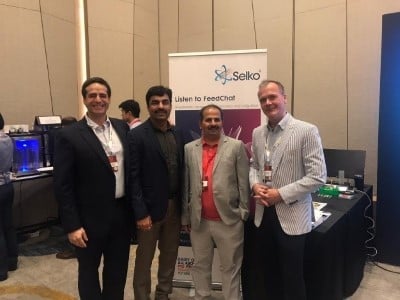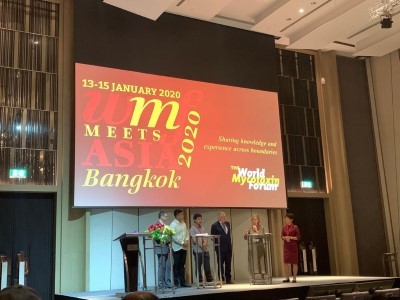World Mycotoxin Forum Meets Asia: Key Learnings
- Press release
The significance of mycotoxins in the food chain is manifold. Historically they have been recognised for causing hallucination and gangrene in humans. Since the outbreak of aflatoxicosis in turkeys in The United Kingdom in 1960’s, the research and awareness on these fungal toxins skyrocketed. Mycotoxins affect human and animal lives through their impact on economic, social and health aspects (Table 1).
Acute mycotoxicosis in humans have drastically reduced over the last few decades, but not completely eliminated. A case of acute aflatoxicosis killing 20 people was reported as recently as in 2016 in Tanzania. The population was exposed to corn contaminated with 50 parts per million (ppm) aflatoxins (WMJ, 2018). Liu and Wu (2010) reported between 25,000 and 155,000 global annual human liver cases were attributed to aflatoxin exposure.
Table 1. Socio-economic impact of mycotoxins
|
Sl. No. |
Parameters |
Associated Costs |
|
1 |
Crop damage and poor yields |
Lower value, trade losses, destruction costs |
|
2 |
Additional sourcing of raw materials |
Logistics cost / lack of local knowledge |
|
3 |
Decreased efficiency in livestock production |
Poor weights, egg production and milk production related revenue losses |
|
4 |
Animal welfare (livestock, pets) / human health |
Health costs |
|
5 |
Mitigation and intervention costs |
Grain treatment costs, mycotoxin binder development costs |
|
6 |
Quality Control challenges |
Cost of testing, capital investment on labs |
|
7 |
Hunger (Africa/Asia/South America) |
Can’t be measured in terms of money |
Source: Niemeijer, WMFmeets Asia 2020
The significance of mycotoxins is so high that once in two years experts from all over the world join at “The World Mycotoxin Forum” (WMF) to discuss various aspects related to mycotoxins. WMF is the leading international meeting series on mycotoxins where food and feed industry representatives meet with representatives from universities, governments and regulatory bodies from around the world.
For the first time in January 2020, WMF came to Asia. The event was conducted in Bangkok, Thailand from 13th to 15th January. The 12th conference offered a unique platform for the food and feed industry, science and regulatory authorities to exchange current knowledge, to promote harmonization of food and feed safety regulations and control procedures, and to make recommendations for integrated strategies ensuring the safety and security of food and feed supply chains. Plenary sessions were chaired by Prof. Rudolf Krska, Department IFA-Tulln, BOKU Vienna, Austria and Prof. Chris Elliot, The Institute for Global Food Security, Queen’s University Belfast, Northern Ireland.
Trouw nutrition was the Gold Sponsor for this event, aligning with our mission of Feeding the Future. Serving as a gold sponsor of WMFmeetsAsia underscores our efforts to help animals attain their full genetic potential. Mitigating mycotoxin in feed helps protect animal’s health and performance while sharing knowledge and solutions with other stakeholders at venues such as WMFmeetsAsia is integral to managing mycotoxin risk.

Figure 1. Trouw Nutrition team at the event
Why Asia in 2020?
Until last month, WMF was conducted only in Europe. The organizers selected Asia for the obvious reasons. Asia is the largest and the fastest growing animal industry in the world. The crop growing conditions of high temperature, rainfall and humidity make commodities highly susceptible for mould contamination and mycotoxin production. Many Asian countries are looking at exporting agricultural products, such as spices, coffee, meat and milk, to western countries and hence need to follow mycotoxin regulations set by European Commission and FDA in US. Therefore, the organization of WMF event in Asia can attract greater number of stakeholders and provide a platform for effective discussion and implementation of quality standards. The program was oriented more towards Asian needs to provide them helping hands.
Day 1, 13th January:
1. The conference reconfirmed that 25% of world’s raw materials are contaminated with mycotoxins at levels above European Food Safety Authority (EFSA) recommendation. However, up to 60% of raw materials can be contaminated with mycotoxins above the limit of detection.
2. Climate change will enhance the toxigenic fungal growth and mycotoxin production. For example higher CO2 levels combined with higher temperatures further increase aflatoxin contamination in maize.
3. Although all key mycotoxins are not regulated in ASEAN region, there are task forces in place to regulate them in the coming years. Many Asian countries follow either FDA or EU regulations on mycotoxins.
4. Analytical and remediation innovations will continue to evolve from key companies working in this area. Real-time mycotoxin analysis data from the field should be used to monitor and manage mycotoxins effectively.
5. in vitro testing of mycotoxin binders should be done with careful consideration for physiology of the species in question, the mycotoxins in question as well as the inclusion rate of mycotoxin binder to be used under field conditions.
Day 2, 14th January:
1. All the Asian countries shared their share of pain in dealing and regulating mycotoxins in feed and food. There were many presentations from Thailand as it was the host country.
2. Although aquaculture is a fast growing industry, the mycotoxin research and development is limited. There should be more focus on this area in the coming years. Shrimp is very sensitive to deoxynivalenol (DON, limit of 300ppb) and aflatoxins (limit of 30ppb). The amount of mycotoxins present in aqua feeds depends on the aqua species in question and the feed composition. The transfer of mycotoxins to humans via aquaculture can be a potential threat and hence attention is needed.
3. Mycotoxin detoxification innovations should be practical and cost-effective. They should be proven both in vitro and in vivo. Even if they are successful under in vivo tests, clear mode of action should be elucidated. Oxido-reductive enzymes are also showing promises in this direction.
4. Poultry under Antibiotic Growth Promoter (AGP)-free production system are more susceptible to mycotoxins. DON at levels of only 2 ppm was able to cause poor performance in broilers reared in AGP-free production system.
5. Post-harvest loss prevention innovations in developing countries are very crucial. In many developing countries around the world, grain production is not a major issue but the post-harvest management is.
Day 3, 15th January:
Day 3 of WMF was really thought provoking as many food processing scientists asked intriguing questions to the audience. Some of them are as below and an effort is made to relate them to animal industry.
1. Food processing can lead to the generation of new mycotoxin products in addition to the parent compound. Are they less toxic and safe? Can the pelleting of animal feed produces such products? Since most animal feeds are either mash or pellets, more research is needed to ascertain whether pelletizing can produce new mycotoxin derivatives.
2. Mycotoxin biomarker analysis in human blood and urine will give an idea of mycotoxin exposure. Can this be applied in animal industry similar to that of aflatoxin M1 in milk?
3. Can the processing of cereal grains reduce mycotoxin levels? If so, is there any difference among different mycotoxins? Answer is yes. It depends whether toxin is hydrophilic or hydrophobic.
4. Is coffee free from mycotoxins? Answer is no. Exposure depends on the extent of coffee roasting and post-harvest management. Can such coffee waste and other plant by-products get into animal feed?
5. How food and feed fraud is contagious today and can this be done using mycotoxins? Answer is yes. Feed fraud is more rampant than food fraud.

Figure 2. Plenary session on Day 3
Conclusions
The arrival of World Mycotoxin Forum to Asia has really opened the eyes of the local people to the potential socio-economic and regulatory challenges of mycotoxins. The organization of such events more frequently in Asian region will help in mitigating mycotoxin challenges. Such events also help in enhancing the ability of Asian countries to export their plant- and animal-original products to the more lucrative western market.